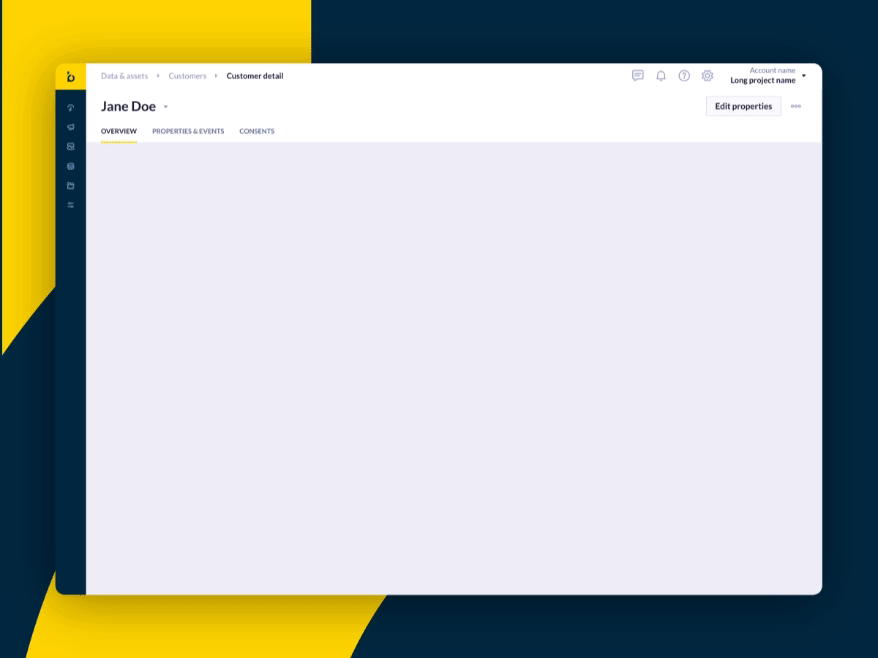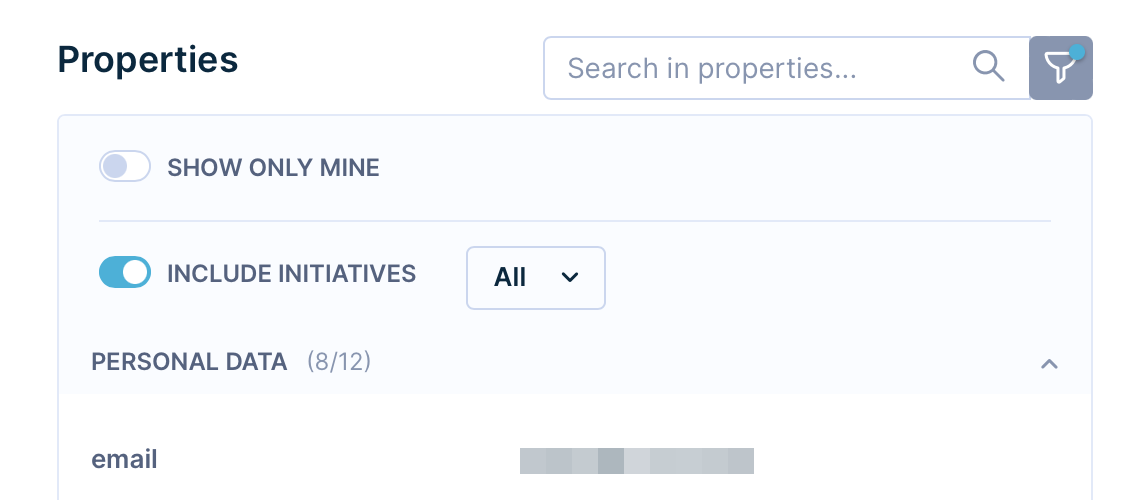Customers
Customers and their events are the principal entities around which Bloomreach Engagement's tracking and analysis capabilities are built. Learn the basics about these entities in the Data Structure article.
Watch this short introductory video about this feature.
Interactive tour
See how we help marketers like you build a Single Customer View with an interactive tour.
E02 15 steps, 3 minutes
This article explains how to access the single customer view in Bloomreach Engagement and features for managing your customer database.
Access the database and basic features
To access your customer database, go to Data and Assets > Customers. You will see the full list of all your customer profiles. Look for a specific customer using the search function or by using the customer and event filter. The search function only searches through attributes that are visible in this list view. You can edit which attributes you want to see and make searchable by clicking on the cog wheel icon in the top right corner of the table.

Download or delete multiple users
You can export the list of all or filtered customers and their selected attributes into CSV by clicking on the 3 dots in the top-right corner. You will be prompted to select which attributes you want to download.
To configure and open a CSV file as an MS Excel spreadsheet, follow this external guide. To preview CSV files, use Notepad++ on Windows or Sublime on Mac.
You can also delete all your customers using the 3 dots icon. To delete only 1 customer:
- Hover your mouse over the row with that customer.
- The Edit button with a drop-down menu appear.
- Click on the drop-down menu and choose Delete.
To delete a customer attribute, go to the Data Manager.
Download customers for a specific segmentation
If you want to download customers for a specific segment:
- Go to the
Customerstab. Download all customers' data by default when clicking on the 3 dots in the upper right corner or narrow customers down by adding filter conditions.

After clicking add filter condition, you can select:
- If you are working with funnels or attributes
- If you want to add an event attribute to your event filter
- If you want to add a new funnel step
- If you want to add another filter condition
- To narrow it down by segmentation, go to
+Add filter conditionand click on theCustomertab. Choose a segmentation you wish to narrow down by and set a segmentation for which you want to download the data by clicking on theApply filters. - After applying filters, click on the 3 dots in the upper right corner and select
Download customer data. Only data matching your filters will be exported.

All customer identifiers are automatically included in the downloaded CSV file. For this reason, they are not available in the selection.
Manage a customer profile

After clicking on a customer profile, you will open the single customer view. Overview section opens, where you can see all the basic information about the customer and their most important recent actions. Click on the three dots in the top right corner if you want to add an event for this customer manually, download all their data in a JSON format, anonymize or delete the customer.

Overview tab
This section provides you with a basic overview of the user grouped into several sections:
Basic information
- Contact information (attributes email, address, and phone are displayed if available)
- Personal information (attributes gender and birthday)
- Selected predictions and segmentations (go to the "Properties and events" tab to see all)
Profile
- Items viewed (count event
view_itemfor the last 30 days) - Purchases (count even
purchasefor the last 30 days) - Revenue (count event
purchase > total_pricefor the last 30 days)
Below, you can see additional information, such as the last purchase and campaign received. If you use recommendations and have an active model running, you will also see what products would be displayed to this customer. You can switch between different recommendation models by clicking on its name.
Multiple catalogs
If there are multiple catalogs in the project, the source of the product can be found in the first catalog that is used in the list. The catalogs are in alphabetical order.
Properties and events tab

On the left side, you can see the full list of identifiers and properties. These also include any dynamic analyses, such as Aggregates or Segmentations, in expandable categories. Properties within each category can be grouped. This grouping reflects the structure set in the Data Manager, which is completely customizable there.
You can search for properties by their name using the search input field, or use the filter button to include (or not) properties that are part of specific initiatives or show only those that were created by you.

When the customer profile is loaded, all of the dynamically calculated analyses are collapsed by default. Analyses are displayed once you expand one of the sections and, to prevent information clutter, only a certain number of items is loaded. If more items are needed to be displayed, you can do so by either clicking on the Load more button or using the search filter to find a particular analysis by its name.
Note that you can also edit the property values for the specific customer when you hover over them. The delete button only clears the value of the attribute for that specific customer. If you want to erase a whole attribute from the project, you can do so in the Data Manager.
Customers can have various types of attributes (and all of these will be displayed on the left side):
| Types of attributes | Description |
|---|---|
| Identifiers | Soft and hard IDs to identify unique customers |
| Static attributes | These are usually set from the SDK or are updated through imports Attributes that don't change often (e.g. first_name, last_name, email, subscription status |
| Aggregates | Calculated in real-time for every customer from events belonging to a given customer |
| Segmentations | Calculated in real-time When a customer belongs to a certain segment in segmentation, the segmentation will be available to use as their attribute |
| Expressions | Calculated in real-time these attributes are derived from the existing ones through custom Expressions |
| Predictions | Calculated in real-time |
On the right side, you can see the full history of all events performed by this customer. Click on an event to expand all its attributes and values tracked. You can search by event name using the text search on the right side, or you can use the filters to search for an event using specific criteria.
Limitations
Customer attributes
There is a limit on the maximum amount of customer attributes per customer depending on your contract:
- 255 attributes per customer with a maximum size of 128Kbits or 16Kbytes per attribute;
- 1024 attributes per customer profile with a maximum size of 2KiB per attribute.
After reaching the storage limit any tracking containing new customer attributes will be discarded. You will be alerted if you approach your limit.
Events
There is a limit of 500,000 events per customer profile.
More events can be tracked but all the events above the limit are flagged as 'archived' (starting from the oldest). Those events will not be used in any analyses. If there is a need for those events, there is still an option in the customer profile (under the menu in the upper right corner) to export the events out of Bloomreach Engagement.
If an impacted customer profile is open in the application properties like segmentations, aggregates, and expressions do not load and a warning message is shown.
The list of customer profiles above the 500,000 limit and close to the limit (above 400,000) is available in the health dashboard of every project. Additionally, an email is delivered to the supervisory email address of every impacted project and to the subscribers of the health dashboard.
Under normal circumstances, profiles usually have up to 10,000 events, and having more than 500,000 may signal incorrect import or tracking, and is definitely worth investigating.
Note that:
- Archived events do not expire and can not be deleted via the delete feature in the app.
- Archived events are available in Bloomreach Engagement Big Query.
- Archived events are not exported using the Data Exports feature.
- Archived events can be exported from the customer profile.
- To delete the archived events, the whole customer profile needs to be deleted.

Consents tab
Here you can monitor and manage consents manually for every customer. Read more in the Managing consents in customer profile guide.
How are customers created
Bloomreach Engagement automatically creates a customer record for every first-time visitor of your website on their device, thereby triggering Bloomreach Engagement's initialization code. This process creates a hard identifier (usually called registered) and an identifier cookie that allows Bloomreach Engagement to track the customer, including their subsequent actions and sessions. The nature of the hard identifier depends on how your project is integrated. It's usually the user's email address or some internal ID your company is using. You can also create new customers by importing them or manually from the customers' list view.
There are situations where Bloomreach Engagement creates several customer records for a single customer, for instance, when a customer browses your website using multiple devices. Bloomreach Engagement automatically merges these records when matching identifiers are provided (for example when the customer logs in to their account from the other device).
Updated 9 months ago
